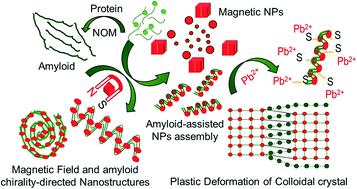当前位置:
X-MOL 学术
›
Environ. Sci.: Nano
›
论文详情
Our official English website, www.x-mol.net, welcomes your feedback! (Note: you will need to create a separate account there.)
NOM-assisted, amyloid-enriched, hierarchical self-assembled nanostructures of maghemite nanoparticles and their plastic deformation: role of magnetic fields, Pb2+, and biomolecular conformations
Environmental Science: Nano ( IF 7.3 ) Pub Date : 2022-07-13 , DOI: 10.1039/d2en00540a Qijing Xu 1 , Hui Dong 1 , Zhenquan Wang 1 , Bo Su 1 , Di Zhang 1 , Nihar R. Pradhan 2, 3 , Saikat Ghosh 1 , Bo Pan 1 , Baoshan Xing 4
Environmental Science: Nano ( IF 7.3 ) Pub Date : 2022-07-13 , DOI: 10.1039/d2en00540a Qijing Xu 1 , Hui Dong 1 , Zhenquan Wang 1 , Bo Su 1 , Di Zhang 1 , Nihar R. Pradhan 2, 3 , Saikat Ghosh 1 , Bo Pan 1 , Baoshan Xing 4
Affiliation

|
Sequential sorption of bovine serum albumin (BSA)–humic acid (HA)–BSA on weakly ferromagnetic maghemite nanoparticles has achieved the formation of amyloid scaffold-controlled self-assembly (B2-GFeNPs) at pH 4. Unlike BSA-modified maghemite (B1-GFeNPs), which has stronger magnetic dipolar interaction-mediated random aggregation, the liquid crystalline nature and nanoconfinement effects of the amyloid scaffold controlled the growth of highly ordered colloidal assemblies of B2-GFeNPs. These assembled structures undergo topotactic transformations due to Helfrich membrane bending when the suspension pH is increased from 4 to 7. In the presence of an external magnetic field, and at pH 4 these self-assembled structures underwent screw dislocation-driven growth; for example, nanowires and helicoidal and disc-like colloidal crystals. The formations of micropipe-like open core screw defects with a higher magnitude of the Burgers vector of the colloidal clusters were also observed. The interaction of Pb2+ (0–100 μg L−1) within the amyloid backbone of B2-GFeNP clusters at pH 4 produced an FCC-like geometry and resulted in moderate to severe plastic deformation, including slip, with increasing concentrations of heavy metal ions. The signatures of plastic deformation, including dislocation dipoles, prismatic loops, stacking fault tetrahedra, and twin boundaries were observed. At pH 7, the topological transformation of B2-GFeNPs and Pb2+-induced elastic strain caused a dislocation pile-up, which represented the zincblende {111} face. The dislocation reactions produced from the mutual interactions between the Shockley partials (which evolved from the stacking faults) with Burgers vectors  and
and  that moved along {111} planes resulted in the formation of a Lomer–Cottrell (LC) barrier with a stair-rod geometry. Therefore, Fe–NOM coprecipitate interactions with heavy metal ions or soil colloids isolated from metal-contaminated soils may provide the morphological signatures of elastic strain-mediated geometries.
that moved along {111} planes resulted in the formation of a Lomer–Cottrell (LC) barrier with a stair-rod geometry. Therefore, Fe–NOM coprecipitate interactions with heavy metal ions or soil colloids isolated from metal-contaminated soils may provide the morphological signatures of elastic strain-mediated geometries.
中文翻译:

磁赤铁矿纳米粒子的 NOM 辅助、富含淀粉样蛋白的分级自组装纳米结构及其塑性变形:磁场、Pb2+ 和生物分子构象的作用
牛血清白蛋白 (BSA)-腐植酸 (HA)-BSA 在弱铁磁性磁赤铁矿纳米颗粒上的连续吸附在 pH 4 下实现了淀粉样蛋白支架控制的自组装 (B2-GFeNPs) 的形成。与 BSA 修饰的磁赤铁矿 (B1 -GFeNPs)具有更强的磁偶极相互作用介导的随机聚集,淀粉样蛋白支架的液晶性质和纳米限制效应控制了 B2-GFeNPs 高度有序的胶体组装体的生长。当悬浮液 pH 值从 4 增加到 7 时,由于 Helfrich 膜弯曲,这些组装结构会发生拓扑转变。在存在外部磁场的情况下,在 pH 值为 4 时,这些自组装结构经历了螺旋位错驱动的生长;例如,纳米线和螺旋状和盘状胶体晶体。还观察到微管状开芯螺钉缺陷的形成,其具有较高的胶体簇的伯格斯矢量幅度。铅的相互作用B2-GFeNP 簇的淀粉样蛋白骨架内的2+ (0–100 μg L -1 ) 在 pH 4 下产生类似 FCC 的几何形状,并导致中度至重度塑性变形,包括滑移,随着重金属离子浓度的增加。观察到塑性变形的特征,包括位错偶极子、棱柱环、堆垛层错四面体和孪晶边界。在 pH 7 时,B2-GFeNPs 和 Pb 2+引起的弹性应变的拓扑转变导致位错堆积,这代表了闪锌矿{111}面。位错反应由 Shockley 部分(由堆垛层错演变而来)与 Burgers 矢量 和
和 沿 {111} 平面移动导致形成具有阶梯杆几何形状的 Lomer-Cottrell (LC) 势垒。因此,Fe-NOM 与重金属离子或从金属污染土壤中分离出来的土壤胶体的共沉淀相互作用可能提供弹性应变介导的几何形状的形态特征。
沿 {111} 平面移动导致形成具有阶梯杆几何形状的 Lomer-Cottrell (LC) 势垒。因此,Fe-NOM 与重金属离子或从金属污染土壤中分离出来的土壤胶体的共沉淀相互作用可能提供弹性应变介导的几何形状的形态特征。
更新日期:2022-07-13
 and
and  that moved along {111} planes resulted in the formation of a Lomer–Cottrell (LC) barrier with a stair-rod geometry. Therefore, Fe–NOM coprecipitate interactions with heavy metal ions or soil colloids isolated from metal-contaminated soils may provide the morphological signatures of elastic strain-mediated geometries.
that moved along {111} planes resulted in the formation of a Lomer–Cottrell (LC) barrier with a stair-rod geometry. Therefore, Fe–NOM coprecipitate interactions with heavy metal ions or soil colloids isolated from metal-contaminated soils may provide the morphological signatures of elastic strain-mediated geometries.
中文翻译:

磁赤铁矿纳米粒子的 NOM 辅助、富含淀粉样蛋白的分级自组装纳米结构及其塑性变形:磁场、Pb2+ 和生物分子构象的作用
牛血清白蛋白 (BSA)-腐植酸 (HA)-BSA 在弱铁磁性磁赤铁矿纳米颗粒上的连续吸附在 pH 4 下实现了淀粉样蛋白支架控制的自组装 (B2-GFeNPs) 的形成。与 BSA 修饰的磁赤铁矿 (B1 -GFeNPs)具有更强的磁偶极相互作用介导的随机聚集,淀粉样蛋白支架的液晶性质和纳米限制效应控制了 B2-GFeNPs 高度有序的胶体组装体的生长。当悬浮液 pH 值从 4 增加到 7 时,由于 Helfrich 膜弯曲,这些组装结构会发生拓扑转变。在存在外部磁场的情况下,在 pH 值为 4 时,这些自组装结构经历了螺旋位错驱动的生长;例如,纳米线和螺旋状和盘状胶体晶体。还观察到微管状开芯螺钉缺陷的形成,其具有较高的胶体簇的伯格斯矢量幅度。铅的相互作用B2-GFeNP 簇的淀粉样蛋白骨架内的2+ (0–100 μg L -1 ) 在 pH 4 下产生类似 FCC 的几何形状,并导致中度至重度塑性变形,包括滑移,随着重金属离子浓度的增加。观察到塑性变形的特征,包括位错偶极子、棱柱环、堆垛层错四面体和孪晶边界。在 pH 7 时,B2-GFeNPs 和 Pb 2+引起的弹性应变的拓扑转变导致位错堆积,这代表了闪锌矿{111}面。位错反应由 Shockley 部分(由堆垛层错演变而来)与 Burgers 矢量
 和
和 沿 {111} 平面移动导致形成具有阶梯杆几何形状的 Lomer-Cottrell (LC) 势垒。因此,Fe-NOM 与重金属离子或从金属污染土壤中分离出来的土壤胶体的共沉淀相互作用可能提供弹性应变介导的几何形状的形态特征。
沿 {111} 平面移动导致形成具有阶梯杆几何形状的 Lomer-Cottrell (LC) 势垒。因此,Fe-NOM 与重金属离子或从金属污染土壤中分离出来的土壤胶体的共沉淀相互作用可能提供弹性应变介导的几何形状的形态特征。



























 京公网安备 11010802027423号
京公网安备 11010802027423号